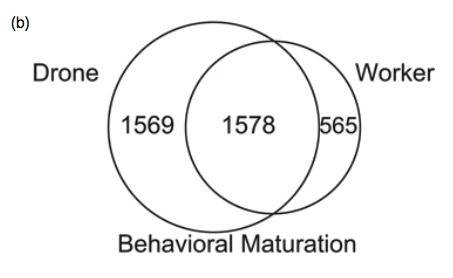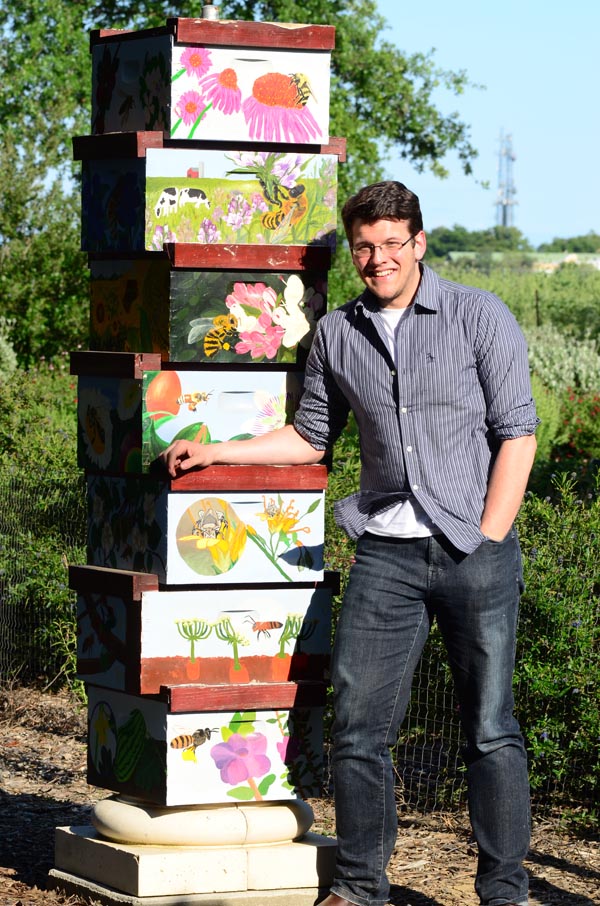Meet the lab @ OE3C
If you also happen to be in Toronto this weekend, drive down to Hamilton to check out Brock Harpur and Dr. Clement Kent talk about our research at the Ontario Ecology, Ethology, and Evolution Colloquium (OE3C), hosed by McMaster University.
Meet the bees @ Science Rendezvous
If you are around the greater Toronto area this Saturday, drop by to see me and the bees at the Science Rendezvous at main street Markham on Saturday, May 12, 2012 between 10:00 am and 3:00 pm . Here is what you can expect.
Amro
New Paper: Management increases genetic diversity of honey bees
I happy to announce a recent article by the lab, which appeared this week in Molecular Ecology, on the effect of management on genetic diversity in the honey bee. [See Press Release]
The honey bee has a very long relationship with Humans – the Pharaohs of Egypt had pictures of honey pots and written documents describing honey trade. The long history of management would suggest that humans have left their fingerprints on honey bee genetics.

Cartoon showing the impact of out-of-African expansions on genetic diversity in Bees. We know that bees originated in Africa (most diverse population), then colonized Europe via two independent expansions; these expansions most likely involved a small number of individuals resulting in low genetic diversity in European subspecies. Human management encouraged interbreeding between these distinct European races which then elevated genetic diversity of managed bees.
Domesticated animals often have reduced genetic diversity relative to their ancestors, because humans often utilize only a small number of progenitors that are then interbred and selected to enhance specific traits. There is a growing concern that honey bees have reduced genetic diversity because of selective breeding by humans, and that this reduced diversity is contributing to the bee’s alarming global declines. This idea is supported by a few studies that showed that European honey bees have reduced genetic diversity relative to African honey bees; the former is believed to be more ‘domesticated’ while the latter is thought to be more ‘wild’. However, the 2006 discovery by Charlie Whitfield and Colleagues that honey bees originated in Africa then colonized Europe throws a wrench at this argument; European bees are expected to have reduced diversity relative to African honey bees simply because of the founder events associated with colonization, and this has nothing to do with management. Actually, we – humans – also evolved in Africa before colonizing the new world and Eurasian human populations have reduced genetic diversity relative to human populations in Africa.
Our team, led by Brock Harpur with the help of Shermineh Minaei, and Dr. Clement Kent decided to revisit this topic by sequencing fragments of 20 random genes from the bee’s genome in progenitor populations in Africa, East Europe, and West Europe, as well as two managed populations in Canada and France.

Fig. 2 from article. Managed honey bees have more diversity when compared with their progenitor populations in East and West Europe.
Just as we expected, we found that managed populations were mostly a mix of east and west European bees (beekeepers favour these bees for their productivity, cold-hardiness, and sometimes gentleness!). But west and east European bees are themselves a product of two independent out-of-Africa expansions; each have reduced diversity relative to Africa because of bottlenecks (a fancy term describing how genetic diversity is lost when only a small number of individuals are picked to start a new population; think of picking only a few M&M’s from a package – there is no way you can capture all of the differently coloured M&M’s from such a small sample).
By moving colonies and subspecies around, Humans brought together two groups of European bees that were naturally separated and distinct. Because Queen Bees naturally mate with 15-20 different males from nearby areas, the resulting managed populations became mixed. This mixing resulted in higher levels of genetic diversity in managed bees relative to progenitors in East and West Europe!
Congrats to Brock for his 1st-1st authored paper, and to Shermineh for her 1st publication.
Brock awarded Elia Scholarship
Congrats to Brock Harpur for wining the ultra-competitive Elia Scholarship from York University. The Elia Scholars Program is York University’s most prestigious graduate award, and Brock will use it to carry out his Doctoral research on honey bee immunity here in the lab. Great job Brock!
Amro
Summer 2012 Cohort
The spring is starting to break in Southern Ontario, just in time to greet the new cohort of summer students joining the lab, including:
Nadia Tsvetkov, our new research associate (and incoming MSc Student this fall)
Jack Xu and Mohammad Mahjoori are summer NSERC undergraduate scholarship students (congrats! its very competitive)
Anna Chernyshova, Arash Soltani and Tabashir Chowdhury are honours thesis students (Anna and Arash are also Research at York students this term)
and Armando Ponte who is doing a summer research practicum.
Stay tuned for updates on our summer research;
Sincerely,
Amro
Jack and the incredible GPA
Happy to announce that Jack Xu, who spent last summer working in the lab as a NSERC undergraduate student, just received the coveted TOP STUDENT honours for the Faculty of Science and Engineering. Jack scored an incredible GPA 8.93 (out of 9)! Check out the YorkU Magazine story, and the video interview. Congrats Jack!
Clement on CTV’s Canada AM
In case you missed it, Dr. Clement Kent, a postdoctoral fellow at the lab, commented on the media buzz surrounding ‘Zombie’ honey bees on CTV’s Canada AM morning show. Check it out here.
New Paper: Drones are from Mars, Workers are from Venus!
I have a new paper out from a collaboration with Dr. Gene Robinson and his group at the University of Illinois at Urbana Champaign. [see YorkU Press Release]
Honey bee societies are composed of three castes and two sexes. Female bees are either queens or workers; the queen bee lays all the eggs, while the workers do pretty much everything else (build the colony by secreting wax, heat and cool the colony, guard it from intruders, nurse and care for young larva, and collect pollen and nectar). Male bees on the other-hand, have a somewhat more privileged life – their entire existence involves finding virgin queens and mating with them! They are fed by workers, but they do not help out with the day to day activities needed to maintain the hive. This form of social organization represents a major transition in animal evolution. How and why do workers forgo reproduction to help their mom and brothers reproduce ?
We are not very far from answering this question. Both queens, workers and drones have the same genes, and some of the recent advances in the field have come from seeing which genes get turned on or off at different times during the bee’s development to give rise to the distinct castes of honey bees.
Queue-in the bee battle of the sexes! Worker bees and drones have some interesting similarities and differences. Drones and workers spend a period of time inside the hive, prior to initiating mating and foraging flights respectively. This transition from in-hive to out-hive activities are also ‘regulated’ by similar hormone and genetics in both drones and workers. For example, juvenile hormone increases the onset of mating and foraging in drones and workers respectively. Also, colonies where workers start foraging early have drones that start going on mating flights early. So it appears that maturation of drones and workers are under the common control of genes and physiology.
What then accounts for the big differences in behaviour between the two? Workers are much better learners (they take fewer risks!), navigators (they don’t get lost as easily!), and they are extremely sensitive to their environment (they can pace their maturation in tune with the queen and their sisters’ needs). The foragers also perform the ‘waggle dance’, which communicates information about the location and quality of food resources to their sisters.
We set-out to study differences in the brains between drones and workers. We collected drones and workers at two time frames; when they are very young and are still in the hive, and after the onset of mating flights and foraging flights. We dissected the bees, and examined which genes are turned on or off in their brains. We found massive differences in the brain profiles of drones and workers (~ 40% of genes had sex-difference).

Venn diagram showing changes in brain gene profiles associated with maturation in workers and drones. From Zayed et al 2011
Many of the genes that showed sex-differences are known to play a role in behaviour, learning and memory in solitary critters like the lab mice and the fruit fly. But the interesting part was that most of the changes in brain profiles that we observed as workers matured were also present in drones. This suggests that the shift from nursing to foraging in workers was built upon an existing program for maturation in insects.
The study opens the door to understanding the genetic and molecular basis of worker behaviour, and how these social behaviours evolved.
Winter talks!
Amro will be giving a seminar at the Department of Ecology and Evolutionary Biology at the University of Toronto on Friday March 9th 2012

